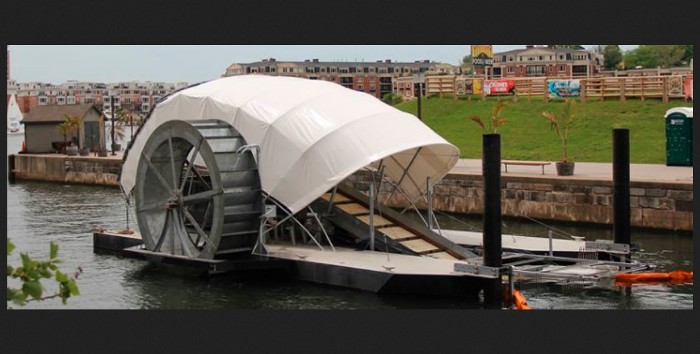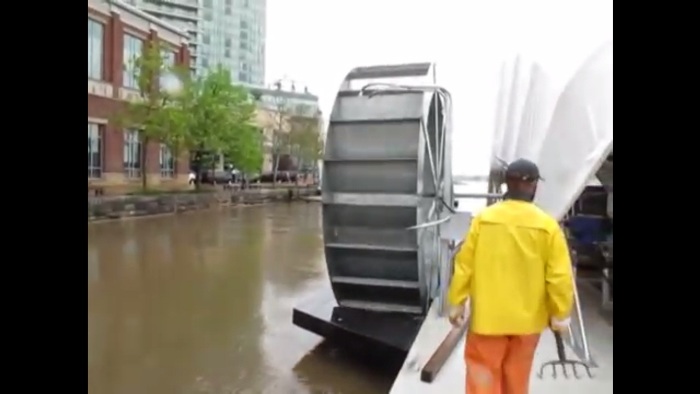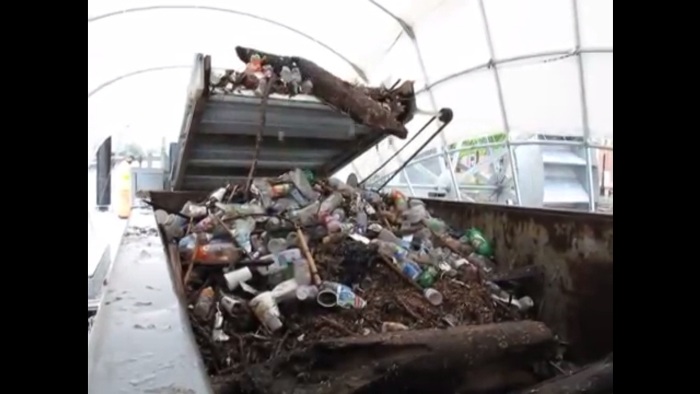This Contraption Is an Impressive Ocean Plastic Cleaning Technology

Cropped screenshot from the Inner Harbor Water Wheel website (http://www.healthyharborbaltimore.org/whats-happening-now/water-wheel)
Reports refer to it as a giant wheel but from some angle, to us, it looks more like a giant snail on the water surface, so we prefer describing it “snail-like.” But whichever way it can be described, this ocean plastic cleaning technology is definitely impressive. it’s not a sophisticated or hi-tech solution but it effectively and efficiently takes out plastic trash from bodies of water.
The oceans already suffer from billions of tons of plastic waste. In a “plastic statistics” presentation by Ocean Crusaders, these excessive amounts of plastic waste contribute to the death of 1 million sea birds. They cause the deaths of over 100,000 marine creatures due to entanglement in plastic. Sailors report that the most common objects they find on the ocean surface are plastic bags. That’s why it’s only logical to put some effort in coming up with an ocean plastic cleaning technology.
Solar-Powered Water Wheel
According to marine science PhD and ocean science website editor, Andrew David Thaler, there is one solar-powered water wheel that is now the first “truly feasible” solution for reducing ocean plastic. What’s great is that it is already in use, in Baltimore, Maryland in particular. It is referred to as the Inner Harbor Water Wheel.
This water wheel contraption is now being employed in Baltimore’s Inner Harbor. It does its work at the outlet of one of the major rivers that run into the harbor, the Jones Falls River. It’s not actually floating but is installed as a fixture. It sits at a location where it can filter out trash and debris from the river through a conveyor belt and into a dumpster barge.

The Wheel – Screenshot from the Inner Harbor Water Wheel promo video posted on YouTube, embedded on the Healthy Harbor website (http://www.healthyharborbaltimore.org/whats-happening-now/water-wheel)
Capacity and Features
The contraption is estimated to have the capability of processing around 50,000 lbs or 25 tons of garbage daily. However, it is reported that the wheel hasn’t actually processed that much amount of garbage yet. The highest amount of garbage it was able to process was 5.13 tons on June 13 this year. On average, the wheel only processed 3.31 tons of plastic trash per day. This is based on its operation from May 16 to July 17. As of July 17, it has already filtered out a total of 62.93 tons of plastic garbage. To emphasize, the low numbers, however, are not something to be saddened about. The amount of trash processed is low because of the relatively low amount of plastic trash that go into the river.
The Inner Harbor Water wheel is equipped with a hydroelectric generator harnessing the current of the river. The hydroelectric generator is the main power source of the wheel. It also has solar panels capable of generating 2,500 watts of electricity. This amount of power is sufficient to supply the needs of one typical Maryland household. The additional power generated from the sun is used to supply the power needs of the wheel when there is not enough current from the river to generate power. There are plans of installing a camera on the water wheel to allow people to see the contraption in action, perhaps to convince more local governments to try doing the same setup upon seeing how effective it can be.

The Conveyor Belt – Screenshot from the Inner Harbor Water Wheel promo video posted on YouTube, embedded on the Healthy Harbor website (http://www.healthyharborbaltimore.org/whats-happening-now/water-wheel)
How It Works
The water wheel makes use of both new and old technology in picking up debris and other forms of trash. As mentioned, the electricity needs are covered by hydroelectric and solar power generators. Electricity is needed to run the conveyor belt. Garbage collected through the conveyor belt is sent to a dumpster, which is eventually towed away when full and replaced with a new dumpster.
According to Thaler, this technology is highly suitable for “major cities with tightly controlled tributaries.” The water wheel is capable of catching debris from a watershed and prevent the trash from going into the ocean, if positioned correctly. So to emphasize, the water wheel is not designed to float on the oceans to collect garbage. It is as preventative solution, not an active way of cleaning up plastic trash that is already on the surface of the oceans.

The Dumpster Barge – Screenshot from the Inner Harbor Water Wheel promo video posted on YouTube, embedded on the Healthy Harbor website (http://www.healthyharborbaltimore.org/whats-happening-now/water-wheel)
The water wheel currently installed at Baltimore’s Inner Harbor is an invention of Clearwater Mills, LLC with Ziger/Snead as the design architect. The same company is responsible for constructing it as funded by Constellation and the Maryland Port Administration, Brown Advisory (additional funding), The Abell Foundation (additional funding), and Marriott Hotels (additional funding). It is however owned and maintained by the Waterfront Partnership of Baltimore. Trash disposal, on the other hand, is provided by the Baltimore City Department of Public Works.
This technology is something many cities should consider using. It is not as ambitious and large-scale as Solar Roadways but it is definitely a useful technology. The benefits it promises to deliver are very much needed especially with more people inhabiting urban areas and recklessly dumping plastic garbage everywhere.